#assignment 3 postmortem
Explore tagged Tumblr posts
Text
Assignment 3 Postmortem and Iterations
I did the event part for the Playtesting, our group did 9 playtesting and make notes about the users' actions when they playing the game.
Based on our 1.0 version, playtesting revealed both strengths and issues in the game. Players were confused about power-up functions and unclear game objectives, indicating a need for better guidance and UI cues. However, they found the gameplay challenging and engaging, with strong interest in the story and high replayability. While results suggest experienced players appreciated the narrative more, the small sample size limits broader conclusions. To improve, the game should clarify mechanics, enhance onboarding, and refine visual cues. Despite flaws, the game's strong core concept and narrative appeal provide a solid foundation for future development.
Playtesting of Game Version 1.1 shows improved clarity in game objectives and sustained strengths in challenge and story. However, players still struggle to understand power-up mechanics, all scoring them 3/5, indicating the need for clearer cues or tutorials. Objective clarity slightly improved, with most users rating it 4/5. Gameplay difficulty and narrative replayability remained well-received. Though the sample size was small, feedback suggests minor improvements were effective. Moving forward, the game should focus on better onboarding for new players and clearer communication of power-up functions to enhance the overall player experience.
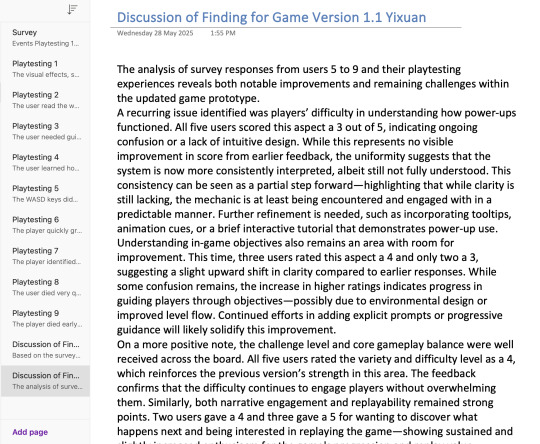


0 notes
Text
Assignment 3 Postmortem
This assignment 3 process has been amazing, to work with a functioning team and understand the full process of using a classic arcade game, and turning it into a fun game for others to enjoy. My team worked exceptionally well together, and helped to create an amazing game in "Rubber Duckie Hero".
My official title for this game was 'designer'. My work consisted of generating ideas for our game, and coming up with interesting challenges, puzzles, and mechanics to make the game more enjoyable.
Other work tasked for me consisted of:
Recording, and editing the video of our game. Here is a link: https://youtu.be/J25BF72KVjU
Designing the shop screen, where I decided to make it a docks area, using the same background as the game, as well as putting the new ships and potential upgrades in bubbles, which would pop when the player purchases it. The player would also be able to see the amount of Rescue Points they have gained so that they know what they can purchase.
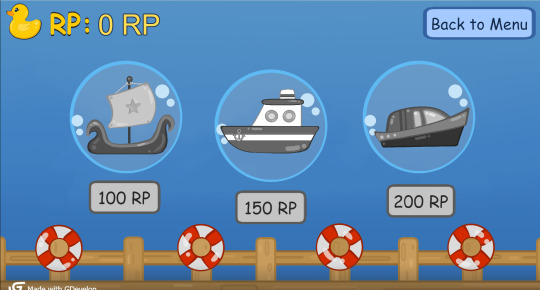
I was also tasked to conduct some playtesting of which I have posted about previously.
In the playtesting report, I wrote about our Participant Demographics, and contributed to our teams Discussion of Additions/Changes. Where I would mainly discuss the changes towards the In Hot Water mode that was outlined during our play tests.
Overall, this has been an incredible experience and I definitely look forward to future projects such as this, where hopefully I will be able to spend more time on and implement more amazing games.
0 notes
Text
Assignment 3 Postmortem
This post is about my assignment 3 game which was a collaborative development with two of my colleagues - Alex and Luke. The game we developed is called 'Swordsage: Oakwood Adventure' and it is a platformer adventure game. Within this post I will be evaluating the development process and explain the design reasonings behind the game respective to my contributions. In addition to this, I will be referencing segments of Game Design Workshop : A Playcentric Approach to Creating Innovative Games, Fourth Edition (Fullerton, 2018) to explain my design reasonings.
Of the three of us who worked on 'Swordsage', I was responsible for level designing. Taking into account that I would be level designing, I had to position myself in the perspective of the players, taking on a playcentric design process and having thoughts such as "what do players generally find engaging in platformers" or "what aspects generally draw players' attention within adventure games". I had to take on these thoughts to draw out ideas that would give players the ideal experience. Through this process, I was able to think of ways to utilise the provided sprites and assets to develop a tutorial level that would give players insight into the possibilities the game had as an adventure platformer. This resulted in the usage of several jump mechanics and traversal techniques, allowing players to challenge themselves by thinking about how they will tackle challenges moving forward in the game. In addition to this, to add more challenge to the game, monsters would be placed appropriately around the map, giving players new obstacles to take on rather than just the platforms.
In addition to this, the game also utilised formal elements, specifically rules, resources, and conflict. These elements were utilised to shape the boundaries and fundamentals of the game. Through having rules such as void boundaries and different interaction outcomes, players would not be limited, but rather led on the right path to explore the game as designed to be, allowing players to experience the game without having conflicting thoughts such as becoming confused or bored as they are guided towards the right path. For resources, the game utilised a health feature, this was developed to give players a value to their health, invoking the need for players to think about how they will handle situations given that they will be reset upon losing all their hearts. In addition to this, to counter-balance the fact that players lose a portion of their health per interaction with monsters, features such as healing statues were implemented to restore the player's health value. As for the conflict elements within the game, players are challenged to progress through a series of platforms at their own pace while taking on monsters along the way.
Now moving forward, I will go on to reflect about the end results of the game's development.
The results of the game came out rather well. People who helped playtest the game were rather happy with its state and gave positive feedback, claiming that the level design was aesthetic, the game was fun, and that the game was easy to get used to. On another note however, there were still feedback that showed discontentment with the game, and in all honesty, that is to be expected and accepted. The current state of the game is incomplete, however, this was due to the inability to find and include more sprites within the game, limiting the development team from improving the overall player experience. In addition to this, GDevelop was also insufficient in the sense that it limited us as developers from being able to run the game smoothly when implementing new features such as special effects to add a more lively feel to the environment.
Overall though, this assignment has contributed majorly to my experience as a game developer in learning as I have learnt multiple things not just from the workshops and the book, but also my colleagues.
Following this section of text will be screenshots and a video demonstrating the current state of the game.
Screenshots of Code:
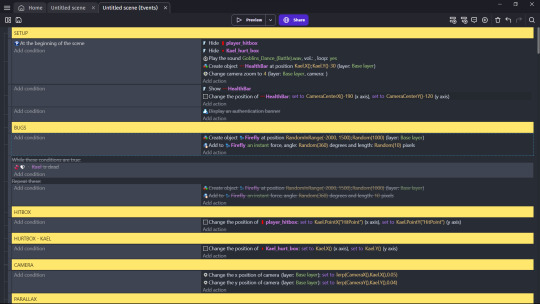
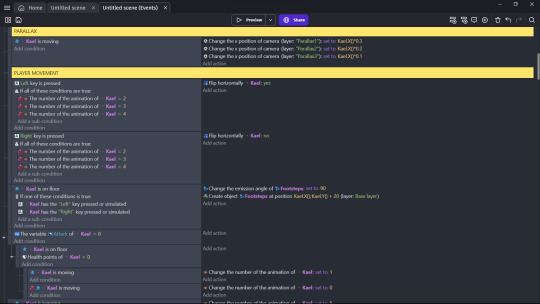
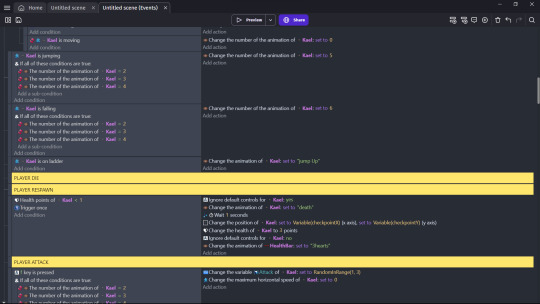

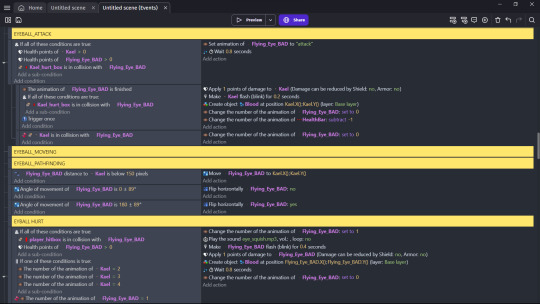

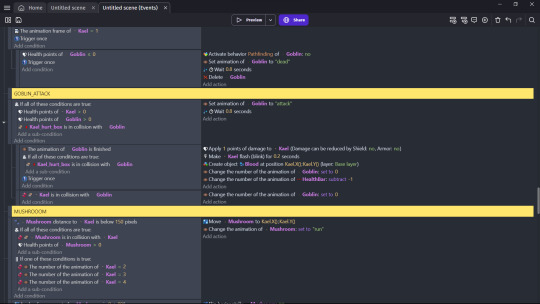

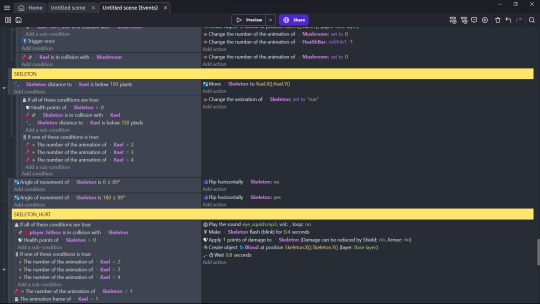
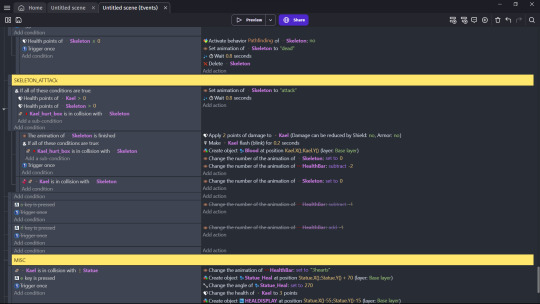
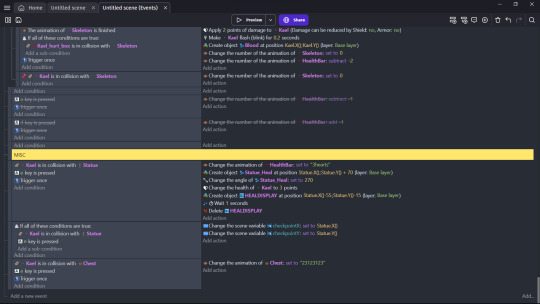
Screenshot of Level Design:
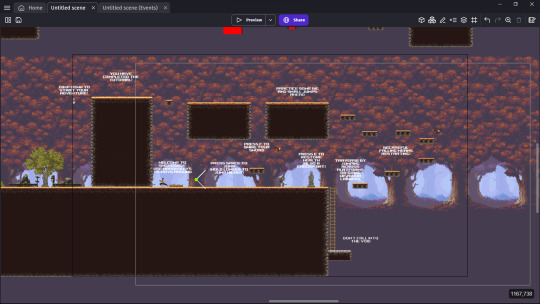
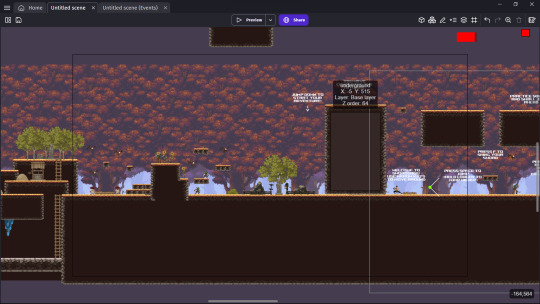
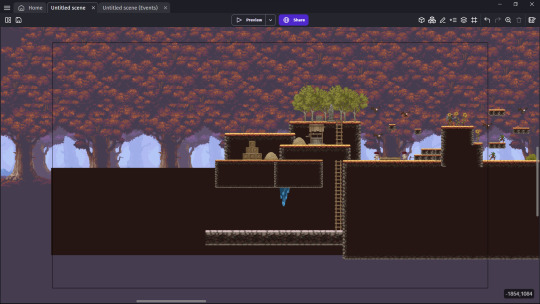
Video of Gameplay:
(my own recording - was also used for the report document)
Reference:
Fullerton, T. (2018). Game Design Workshop : A Playcentric Approach to Creating Innovative Games, Forth Edition (4th ed.). CRC Press LLC.
1 note
·
View note
Text
Assignment 3: Postmortem
We made it! Huge thanks to everyone in my team, it was wonderful working with you all and I'm so grateful that we could bring Rubber Duckie Hero to life together! It was such a rewarding process to birth the initial ideas but then collaborative build the vision as reflected by the iterated one-page document seen below.

Before I discuss changes, I'd like to add this graphic that depicts all of RDH's implemented features for the final prototype.

One thing I'd change about the prototype development process...
It would've been nice to also have a hand in the programming. GDevelop and source control do not go hand-in-hand. To avoid complications, everyone agreed that it would be best for one person to develop the game on behalf of the team. This duty fell to Ann who did an amazing job, huge thanks to you for being incredible! The rest of us worked on art and design iterations and Ann was also exempt from writing the report to balance the workloads, although everyone still facilitated playtesting sessions. But, I digress.
If I could go back, I would've attempted to explore alternative solutions for source control and discussed it more with the team. Although everyone had conflicting schedules, we perhaps could have tried harder to come to a more collaborative approach to programming. In the end, we settled for ensuring that Ann always had our help if she needed it and to consider her workload in respect to the scope. A team of 4 might have crazy ideas but a single developer can only actualize so much of that vision--maybe we could have done more if we split the programming more evenly.
One thing I'd change about the design...
I would have included powerups and more interesting upgrades. The team devised some excellent ideas such as a purchasable companion that would fly out and collect ducks for you every 5 seconds. The novelty of such ideas would have elevated the experience. Other than that, I am very happy with what has been designed and implemented.
Thanks for reading!
End of post.
0 notes
Text
Assignment 3 Postmortem
Now that the whole project is complete, I’ve been reflecting on it, especially how it could be improved.
From the results of the playtest, the playtesters seemed to like the visual style, but I think there’s still room for improvement. The scenes could definitely use some environmental details like fluttering petals animation or more varied platform elements, and also decorative items in the background. These could make the scenes look richer. Improving character animations, such as making enemy movement or interactions like pulling levers could make the world more lively.
Though from the surveys the playtesters are generous and give our mechanics and puzzles generally high score, the complexity of the game was still one major problem. It’s simply too easy to be fun, even I felt that way. It was a bit frustrating to be honest, but then again I had some time to dwell on it and came up with some big plans for it. First, expanding the sizes of the maps may allow for more interconnected puzzles. Then we could work on the platformer aspect of this game, like introducing moving platforms, more varied enemy behaviors, timed switches that require the players to act fast, and things that could hurt the Shadow, such as light, perhaps? Because the playtesters have commented that it felt like they could just use the Shadow throughout to complete some levels. There isn’t enough incentive to switch back to the player. This could also be improved by some dual-character puzzles that would put both characters to work and operate two levers, etc. I also brainstormed some new level mechanics for future development, including gravity-inversion levels and levels that separate the Shadow and the player into two perspectives. I also feel like I should probably integrate the story into these levels, since currently there’s not much story in this game. I also thought of adding collectables, such as hidden mementos that contain fragments of the story, and obtaining all of them could unlock a secret ending. These changes could potentially strengthen the relationship between story and gameplay, improve player engagement and make the game more challenging and fun, though further testing is definitely required.

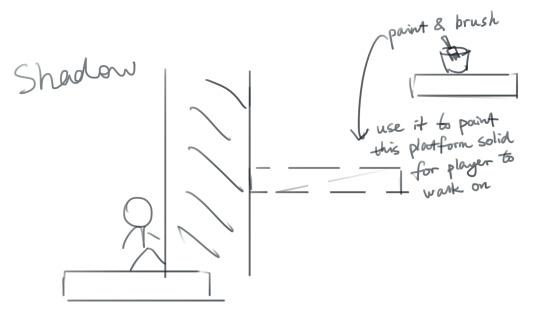
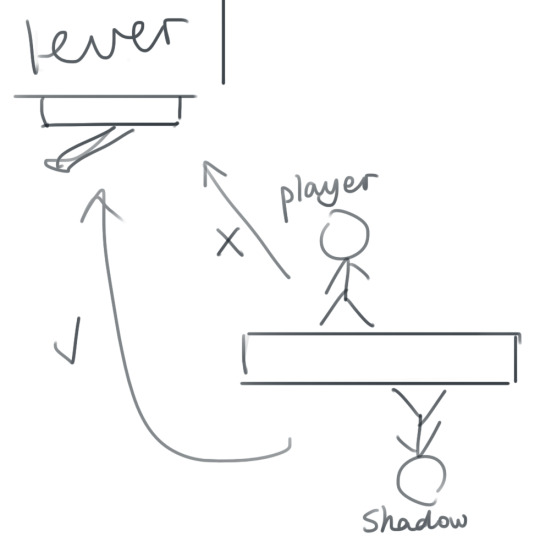
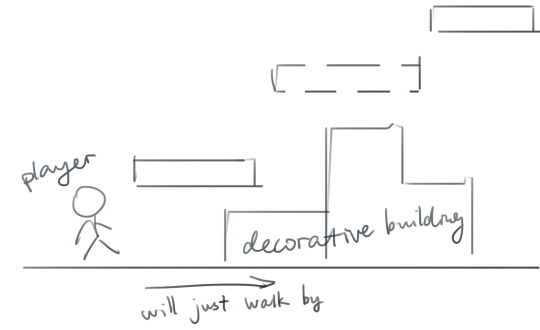
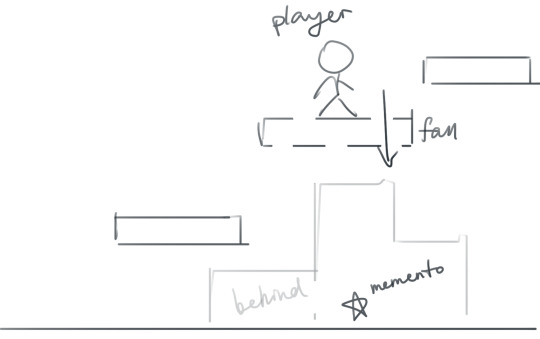
Aside from these, there are also a few necessary quality-of-life improvements, such as adding sound feedback for character death, making shadow portals two-way, creating a level selection menu and so on.
Overall, this project provided me with many valuable insights with game design and game development. Despite the challenges, building this game with my team has been an incredibly rewarding and inspiring experience. I’d say we collaborated well and it was an enjoyable project. Given the chance, I would like to keep working on it in the future since I personally like it a lot.
To conclude, this has been a fun unit that taught me a lot of things. It gave me some really helpful hands-on experience about developing games, working on a project with a team and playtesting. Thank you for reading my blogs!
0 notes
Text
Week 13:
Entropic Collapse: Assignment 3 - Postmortem
0 notes
Text
Week 14c- Hell Riders Postmortem
The assignment said that this was a week 13 task, but the assignment is due in week 14 and I believe having the final posts posted when the assignment is due is more appropriate as I can mention all of the final changes made to the game before my final comments...
The Game
I am vey happy with what we were able to get done with the game and how the game does meet the MVP for the most part
My Role as animator and director
With my role as animator/artist, I am pretty happy with what I was able to get done.
As for my role as the main directing force behind the game, I do feel like I could have done more to get the team moving. There were times where I told the team what to do and it would be done, but there were times when one or two members were waiting around to be given tasks.
I know at points there were times that I did have to get into the coding side of the game as a result of these points of inaction.
My Team
When I do put things into perspective, not many people in the team actually worked on the game code itself. Most of the game itself was made by me and Sage while Nishant and Mahzar worked on other sides of the game like gathering playtesters and making the backgrounds.
Where to Improve Upon?
I will admit, we were a little slow at the start. We could have started this game's development within week 10 if I remember correctly however we decided to hold back on that thought and instead took a week to decide on which game to continue with. If we came to a decision during that week then we might have had enough time to get more of the game complete such as Bel's second phase and other MVP tidbits.
0 notes
Text
Week 13:
Assignment 3 Post Mortem:
This assignment was started by picking one game individually that we had created throughout the semester for each group member (4) then breaking it down into just one game where we will then start to enhance the game to a standard where the player should be able to complete the game and enjoy the visuals and overall design of this game. We decided to use my asteroids game which was a simple survival asteroids game while also protecting a planet, which we collectively decided to change into a game with multiple levels and also include an upgrade system. We split the work in 3 ways, we had myself and one other member working on the game itself, one on the documentation and our last member was working on the visual aspects drawing our assets. During the development of the game a group member worked on improving the game collaborating with me on what to improve and what would be good to add then we relayed that to the group and decided if that would be good to add. Then we also decided that the visuals we had were pretty bad so one of our 4 group members started designing a different UI for the game which unfortunately was not implemented before we had to playtest the game for our 5 reviews of the game. Which leads to the playtesting, which we received a lot of feedback from which consisted of only a small amount of actual game bugs but was mostly based on the difficulty of the game and the UI itself.
If I had a chance to redesign my game I would first add more levels to spread the difficulty curve across as I believe this would be the best solution for the difficulty problem that we had during the playtesting phase of the game. Next I would have implemented the updated UI before the playtesting happened to see if our assets would have been good in the eyes of the play testers. Following this redesign I would then implement more upgrades that can be bought as well as a lock on some upgrades for example you would have to get past level 5 before you can buy the ability.
0 notes
Text
Assignment 3 Postmortem
During the development of Zombo-Alpha: Deathrun—a game combining vehicular combat and zombie survival—I gained invaluable experience in teamwork and game design. As emphasized by Fullerton (2018) in Game Design Workshop, we adopted a playcentric approach, continuously refining the game through iterative testing and player feedback. This process deepened my understanding of player-driven development and its critical role in creating engaging experiences.
Over several weeks of collaboration, our team established an efficient workflow. Programmers focused on optimizing vehicle physics and combat mechanics, artists crafted detailed zombie designs and atmospheric environments, and designers fine-tuned progression systems and difficulty scaling. This structured division of labor highlighted how each team member's expertise contributes to a successful project. Notably, our weekly playtesting sessions revealed crucial design insights, such as the unnatural feel of vehicle controls and unclear upgrade mechanics.
This project not only strengthened my technical skills but also demonstrated how theory translates into practice. Fullerton’s principles—rapid prototyping and player-centric design—were validated throughout our development cycle. I look forward to further refining this game and hope to collaborate with this talented team again in the future.
Reference: Fullerton, T. (2018). Game Design Workshop: A Playcentric Approach to Creating Innovative Games. ProQuest Ebook. Retrieved from: https://ebookcentral.proquest.com/lib/qut/reader.action?docID=5477698
0 notes
Text
A3 Postmortem
I’m proud of how our group worked together for this assignment! We split up and delegated 4 tasks for each person and set priorities from high-low. We always communicated well with each other, and I think we were a great team!
If we were to develop this further, I would definitely improve the UI I made for the dragon’s powers. Right now, we only have a flame image which confused players when they played as the water dragon for example, since the elements don’t match. I would also modify the script of it since some players got confused and tried to shoot at the start of the round when the flame was still regenerating but the UI didn’t display this.
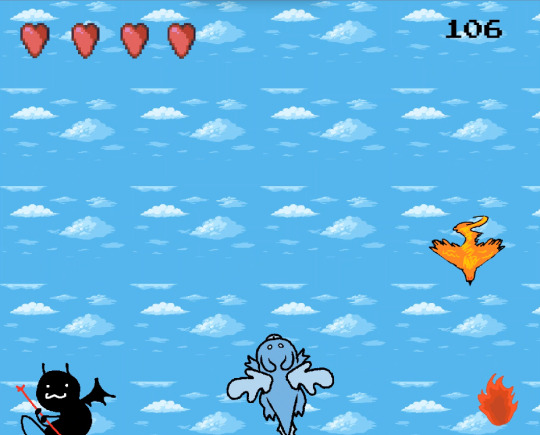
I believe we would also benefit greatly from more playtesting sessions to determine if the game’s difficulty needs to be adjusted further on in the game since some playtesters reached a point where they just kept on surviving. To do this, we could collect data on at which points they are surviving more often to determine when the difficulty level should increase over time. We would balance this based on the median skill level.

In the textbook, Game Design Workshop chapter 10, Fullerton states, “Balancing for the median skill level requires playtesting with players from your target audience across the range of ability levels – from novice to hard-core gamers”. We would first need to determine at what point more skilled players reach a point where they aren’t struggling at all, compared to how low-leveled players progress. It would be good to do this to find a balance between levels and find at what point we should be adjusting the difficulty.
1 note
·
View note
Text
Assignment 3 postmortem
With assignment 3 now completed a postmortem will now be done.
With Assignment 3 many different chapters of the readings helped me specifically chapters 3, 4, 6, 9 and 10 which all provided different aspects for both the game design and report writing. With chapter 3 its resources subheading gave me ideas and allowed me to think of different resources that could be added to the game, this in turn gave me the idea to add a gold pickup. Furthermore the quote for the "Lives" section "More is always better, and there's no downside to earning lives", helped me decide on whether or not the lives upgrade would be kept from the original prototype, ultimately resulting in them staying. Chapter 4 helped with its distinguishing a clear goal which prompted me to add text on the game play screen telling the user how to shoot and what score to get to. Chapter 6 helped with showing me different strategies to brainstorm down my ideas, which helped significantly since I was the only person developing the game and helped me structure my thoughts, The reasons for why is explained in the interesting book chapter post for chapter 6. Chapter 9 helped by giving me an understanding of playtesting before we actually partook in it which allowed me to develop the game in a way I thought the play testers would understand, with this being explained more in-depth in the interesting book chapter post for chapter 9. Finally Chapter 10 helped me with the balancing of the game, with it being the guide to the changes I made in the game such as lowering the health upgrade and the speed of the asteroids on level 2 being nerfed as many play testers found them un-rewarding and annoying respectively.
After going through assignment 3 one thing I would change about how it was developed would have been starting the part B report earlier in playtesting as it would have allowed me more insight into my game design and the problems in it, as me and the group would have been analyzing the playtesting data earlier possibly providing a better gaming experience for the further play testers. Also I would have for the game tried to release more versions of the game then just 4 so we could have the play testers test more bugs in the game instead of repeating the ones found by previous play testers.
Along with this one thing I would like to change about the design process of assignment 3 is specifically adding a boss level at the end of the game as after playing 3 levels the play testers felt like they had not really accomplished anything and were unsure of what to do now, as there was no "you win" or "game done", which made the game feel kind of boring or lackluster in my opinion. The reading that would have helped here is chapter 4 with it discussing how you should try to make the game engaging as most play testers were not upset/wanted to keep playing after we said to stop.
After this post I will have one final post being an interesting book chapter I would like to discuss.
Here are some images from our game Solar Bastion:
Title Screen

Playing Level 1

Upgrade Screen
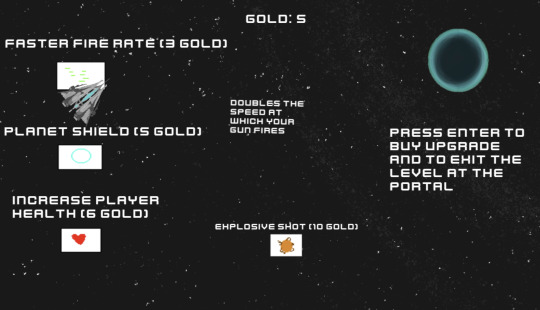
Level 2
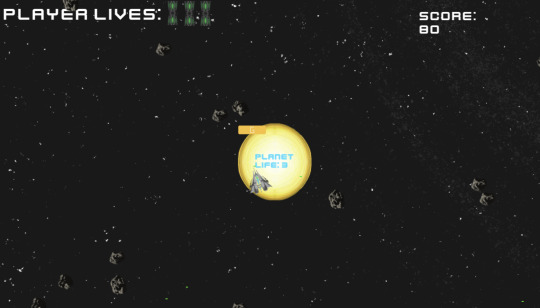
Level 3

Sources used in this post are:
Fullerton, T. (2018). Game Design Workshop: A Playcentric Approach to Creating Innovative Games. ProQuest Ebook. Retrieved from: https://ebookcentral.proquest.com/lib/qut/reader.action?docID=5477698
0 notes
Text
Assignment 3 post mortem
The insights gained from playtesting: The most apparent result from playtests was that players were slow and sometimes unable to understand the mechanics of the game. This was most evident in our first playtest where the game featured instructions on how to start the game. Our first tester, knowing literally nothing about the game, was sceptical that it was a joke because he couldn’t interpret the instructions we had laid out.
The subsequent playtests helped us gradually realise another quirk of learnability design in games. At the start of the first level, the player was shown a disappearing/toast message that explained the basic controls and goal. Most players only noticed subsequent popups like this in later levels when they were actively lost and seeking instruction. This told us to me more intentional about directing player attention around the screen.
Our core playtester, who was slightly more familiar with the genre paradigms, recommended not a higher difficulty level but more variety in the challenge in the form of different enemy types. This fell in line with most of the answers to our survey question, “I felt the game challenged me in a variety of ways.” They were mostly ambivalent to this question.
How the game ended up: The final prototype ended up with, at the very least, better learnability than it started with. The balancing changes have been mostly ironed out with gold now scaling not only to your performance in each level but as you progress to higher levels. This removes the incentive for players to redo level one to collect gold as there is more to be gained further through the levels. Some of the more obtrusive sounds were removed to declutter the audio and only play background music and sounds that inform and reinforce to the player their actions. The gameplay and enemies are mostly untouched from their initial conception.
How it could be improved further: Expansion to said gameplay experience would likely be the next logical step in development. Previously mentioned suggestions from playtests like adding enemies that target the player or collision between the ship and planet to force players to work around it are ideas to upend the dominant strategy of keeping the ship in the middle of the planet to shoot at all angles. This gameplay change could still fall under the umbrella of balancing so a real gameplay change might be adding new upgrades to the shop. It would be very easy to lean into the roguelite genre and randomise these upgrades with planned synergies between different items. This is also quite an intuitive idea to a core demographic who play this exact type of progression system often.
0 notes
Text
Assessment 3 Post-Mortem
Over the last few weeks, our group has put in plenty of work into finalising our game, Asteroid., and subjecting it to plenty of playtests. Guided by the advice of the textbook, particularly Chapters 1 and 9, we strived to design a fun and enjoyable experience for the player. Overall, we were very satisfied with the game we designed. The aesthetic was what we intended, the functionality was all present, the sound design and music matched the style of the game as well. We implemented a cutscene, designed new enemies and a brand new wave system to scale the difficulty as the player progresses. Playtesting highlighted several flaws in our game design, but we also had plenty of solutions to hopefully fix these issues and make the game more enjoyable for players.
If we had to redevelop the prototype, the main advice would be to alter the movement physics from the beginning, as this was the most common item of feedback we received. That way, we could spend more of our time during playtesting focusing on other elements of the game. Also, we should increase the ultimate gain, as this would have allowed every player to see the ultimate and give proper feedback on it. Furthermore, updating the UI elements in advance would have allowed players to be less confused regarding their functionality, and can thus devote more of their attention to the game instead of trying to figure out what the various UI elements were for.
If we had to change the design of the prototype, there are a few things we could have altered. Firstly, a greater variety of enemies would have increased the challenge for players, and prolonged the time until players began feeling unengaged, though hopefully these new enemies could keep the player engaged at all times. Furthermore, although we had a score, we originally intended to implement a scoreboard, but we never did. This would be a great way to encourage players to keep trying again to beat their high score, and add in another element of challenge to the game. Additionally, we could have added in various powerups that could briefly affect the moment-to-moment gameplay. The ultimate ability was one such example, though we had planned several others such as a shield or an asteroid storm, however, we never managed to get these implemented. Lastly, adding in a tutorial stage would have helped players understand the objective of the game and combat, the controls and the use of the UI, ideally removing any confusion they may have had before starting the game proper.
Overall, I was very happy to have worked on this game. I had the opportunity to test myself in creating music, something I hadn't done before, as well as work collaboratively on code using GitHub, which I had also not done prior to this project. Working within the design framework of another person's game was quite challenging at first, but once we all understood the intentions of the games original designer, we were able to work within the framework and concept he created to develop his game concept into a fully developed prototype.
Fullerton, T. (2018). Game design workshop : A playcentric approach to creating innovative games, fourth edition. CRC Press LLC.
0 notes
Text
Week 13 - Assignment 3 Postmortem
What I learned
How to collaborate with others in the creation of the game
Making a title screen
Making an interactable tutorial
What I struggled with
There was a problem where building the game will result in the image below happening, though it is now fixed.
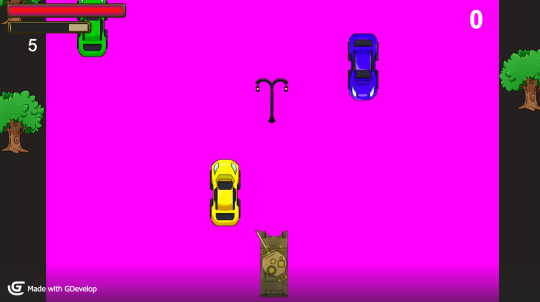
And that's it for my blog posts for IGB120! All in all, I had fun creating all the games for the unit, and will be making more in the future.
0 notes
Text
Assignment 3 Post Mortem
After completing this assessment, I have the opportunity to review my work and learn from it.
The most obvious area for improvement is the aesthetics of the game. Haunted mansion is set in a, well, haunted mansion. And with a setting like that, there's certain aesthetic decisions you expect to create the appropriate.
When I think of haunted mansion, I think of dark colours, particularly blacks, greys and browns. I think of lavish but outdated rooms, covered in dust and cobwebs. And most of all, I think of ghosts. And the latter is really the only part our group delivered on.
The lacklustre aesthetics are in part to the strengths of my team members and I. None of us are artists, or are majoring in animation. As far as I was aware, I was the only one who had taken units that belonged to the creative industries.
Because the aesthetics were lacking, I felt this took away from the effort of the design and mechanics. Despite several testers telling us they enjoyed the game and the movement mechanics, the aesthetics were always our downfall, and likely decreased how much testers enjoyed our game.
Another aspect we could improve on is our time management. Because this assessment was due later than some others, all of us pushed back working on this assessment until weeks 13 and 14, which meant we were behind on testing, and performing tests on a barely developed prototype.
However, there were some parts of this assessment that went well. I believe we had an interesting concept, and some unique enemy movement for the ghosts. I also liked the idea of their being multiple endings based on the player's performance. It's a feature I don't see in many platform games, which typically have a linear story - you die, you start again, or live until you get to the end.
Team communication was also a strength for this assessment. Every week, we made it clear what our tasks were, and what we hoped to achieve for that week. We also made sure to tell the team if we had external commitments that prevented from working on the assessment.
Working on this assessment was an enjoyable experience, which allowed me to identify several strengths and weaknesses in the development process, as well as working in a team.
0 notes
Note
haiii pls spill abt ur chimera yq ideas... i have my own (https://www.tumblr.com/waterfrontcomplex/758520749229277184/dunmeshi-chapter-37ep-17-spoilers-look?source=share)

i also drew my own idea of him (swallow + abundant deer)
Yes ofc!! I'm so happy that someone else has had this idea too, it has so much potential. I want to see all the chimera Yanqings.
Mine looks like this. I actually didn't have a design drawn out for him initially, so I had to whip something up quickly. That's why it took me so long to answer </3

Originally, he had a more swallow-based design.
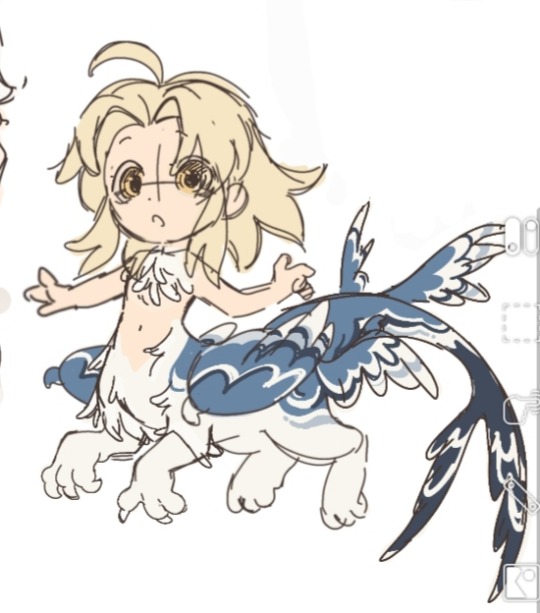
I still really like it, but I changed the lore a lot, so I made the new one, the current au, which goes something like this:
(CW for blatant body horror, descriptions of digestion, as well as brief details regarding real world animal death)
Here's my idea. Like most aeons, Lan The Hunt has emanators that carry out their will. One of these emanator's is currently unnamed and without a solid design yet. It has an animalistic appearance in my head. Imagine Feixiao's inner beast, or the Mourning Aix from WuWa. That'll give you the best reference.
It travels the cosmos, tracking down and eliminating the Abundance. it does this with the use of extremely powerful olfactory cells. Even with galaxies separating them, the emanator can detect abominations through smell alone, and when it finds one, it will consume it to ensure it cannot possibly regenerate.
Suffice to say, it's very good at its job, and Yanqing, unfortunately, is not an exception to their heightened senses. Surprisingly to no one, Abundance Yanqing coexists with this au, and he is immediately recognized as an abomination when the emanator is in proximity of the Luofu. Yanqing is unaware of his status as an spawn of Yaoshi, so when the devourer of monsters (working title) visits the Luofu, he never would have expected it to turn its eyes onto him.
To say the Luofu is thrown into chaos when one of Lan's emanator's eats a Liuetenant of The Hunt is an understatement. The emanator insists no mistake has been made and it is justified through Lan's divine will. It actually shifts the blame onto Jing Yuan for assigning an abomination as his Lieutenant in the first place, citing incompetence on his part. Kind of a shitty thing to do after eating the man's son but okay...
Not long after, the emanator starts to... change. It begins experiencing sudden and visible signs of mara: bouts of aggression, delirium, and eventually flora and fungus sprouting from its flesh. It's incorrectly concluded that Yanqing's death was a result of early unset mara in the emanator, and Jing Yuan decides the emanator has to be killed via decapitation, such is their duty as followers of The Hunt.
You can probably guess where this is going.
So, you know how bones are capable of fusing together or into other objects during the healing process? Like that deer that was shot by an arrow and the ribcage actually fused itself with the arrow? That's essentially how chimera Yanqing is born.
As an abomination, Yanqing is capable of postmortem regeneration, and as an abomination that is particularly favored by Yaoshi (in my delusional mind) his regeneration capabilities far exceed that of the average denizen, and one this emanator's digestive system was not capable of overriding.
Much like how that deer bone fused with the arrow, Yanqing's body begins the process of fusing back together after partial consumption, and during that process, he inadvertently fuses with the emanator's body, which triggered those mara symptoms. Additionally, because there had also been remains of other denizens in the emanator's stomach, they were unintentionally included in the revitalization process. This, in the end, gave the chimera's body the claws of a Borisin, the wings of a Wingweaver, and the head of a human (his body structure is also the same as the Houyhnhnm, but that's obviously a coincidence on my part lol).
The flowers and mushrooms don't really serve any other purpose besides looking pretty and emphasizing his connection to the abundance - his power is so palpable that life is literally sprouting through his skin. I just think it's kinda neat.
Anyways, in terms of psychological aftereffects, Yanqing himself is still there. However, his sense of self is muddied and most of his memories suppressed. Because he's at the head, he's in control of his own movements and actions. Usually, he's completely docile, but in the face of people currently trying to kill him, he becomes confused and scared, and fights back in self-defense. He's also experiencing prolonged dysmorphia from his new form, which causes him greater confusion and even pain.
For Jing Yuan? I think everyone would agree he wouldn't want to kill Yanqing. He believes there's still a way to reverse Yanqing's affliction, even if the Ten Lords insist otherwise.
Currently I don't have an detailed outline of what happens next. My current ideas are similar to yours actually, where the disciples take an interest in Yanqing for whatever reason, be it desperation to stop the Luofu from killing him and seeing him as blessed by Yaoshi, what have you. It could honestly go a similar route as Dvalin's manipulation by the hands of the Abyss. If I were to give this au a happy ending, I could incorporate the Viscorpus' ability to shapeshift and have Yanqing hone that ability, allowing him to regain his human form.
That's all I have for what was meant to be a short, detailed summary </3 All these asks always end with me yapping, forgive me. I've had this au cooking in my head for so long now, and I'm glad I have an excuse to spurge about it now.
(p.s. pls make more of your chimera au, I would eat it up)
#the design might change. we'll see#ask#honkai star rail#hsr#yanqing#chimera yanqing au#abundance!yanqing theory#i dont really like how i drew the fungus tbh#i wouldve made it more detailed but that wouldve taken forever#long post#btw the suspicious amount of notes with no users isn't a bot#my friend's account is just scuffed to an abnormal degree </3
184 notes
·
View notes